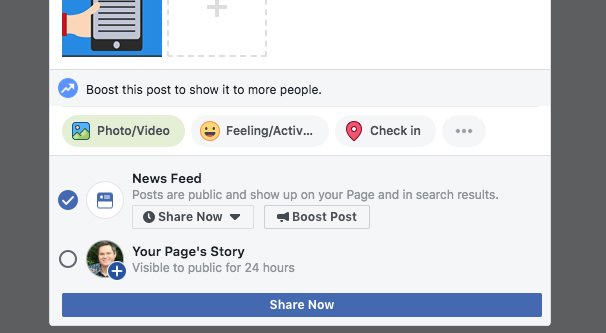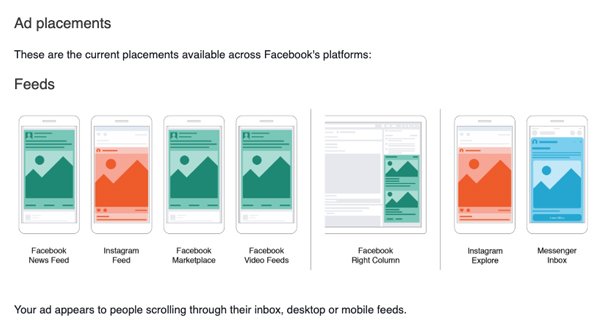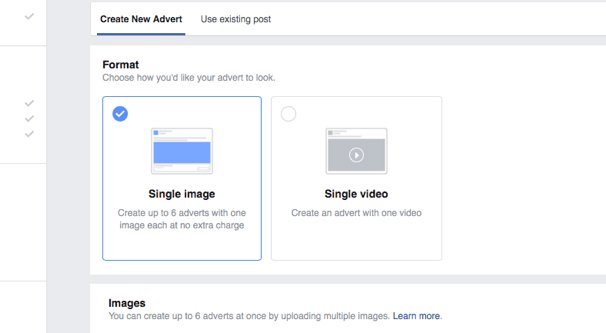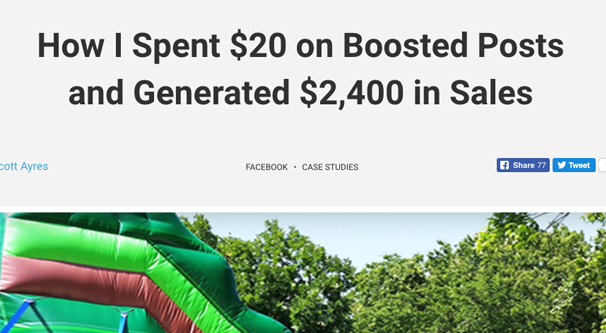10 Differences Between Boosted Posts and Facebook Ads
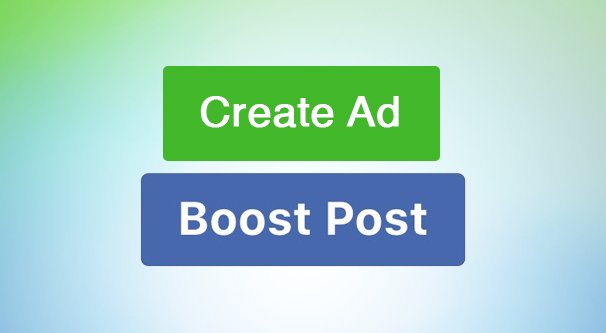
Boosting posts on Facebook is a common introductory way to get used to spending money for added value on Facebook, but that’s all it should be. Too man people mistake boosting posts for “simple” Facebook ads, not realizing that “simple” also means “limited” and “ineffective” for just about everything a real Facebook marketer wants.
So why is boosting posts so popular? Two reasons. The first is that boosted posts are a good way to get more immediate engagement on your posts, which can sometimes translate into more followers. It’s not necessarily the most money-efficient way to get those followers, but it’s very easy and it’s very simple to do. That makes it an attractive option.
The second reason is simply that Facebook pushes it very hard. Every page owner knows the familiar “boost this post” pop-up they have to close a dozen times a day. Obviously, Facebook loves it because it’s a great way for them to get money from people who don’t know any better. How else are they going to make obscene amounts of money on a monthly basis?
If you’ve conflated boosting posts with Facebook ads, or if you want to know exactly why the two are not equivalent, here are the ways the two are not alike, and why Facebook ads are so much better.
1. Boosted Posts Are Not Created in the Facebook Ads Manager
The first primary difference is a mechanical one. Facebook ads can be created through the Facebook Ads Manager interface or through the Business Manager platform. They used to have access to something called the Power Editor too, but Facebook only used that to test advanced features, and once they rolled those features into the main two platforms, they discontinued the editor.
Boosted posts, by contrast, are created directly from your page post feed. You make an organic post and you can convert that post into a boosted post with a few simple options, setting it and letting it run with just a few clicks.
While this does mean boosted posts are more convenient, it means you lack a huge array of possible tools you can use to make those ads better. That’s basically what the remaining nine points will be about.
It should be noted that you can still “boost” posts as Facebook ads, you just need to do it from the ads manager. You can easily convert an existing post into an ad without having to go through the boost post menu.
2. Boosted Posts Have Limited Customization Options
When you boost a post, you get to set three different settings. A general “who you want to reach” which is a very basic audience selection, a maximum budget number, and a duration for your boost.
You can set all of these with Facebook Ads, only you can set them with a whole lot more options. Instead of just choosing a general audience target, you can access a huge array of targeting options, which is important enough it’s its own point later on this list. Instead of choosing a maximum budget, you can choose budgeting and spending options. And, instead of choosing just a duration, you have a lot of advanced scheduling options.
Boosted posts exists to simplify the process of creating an ad, and while that’s a good introduction to advertising, it’s like teaching a grade school kid the basics of economics. Sure, they’ll get the general idea, but they’ll be bad at it if they try to put their knowledge into practice. Boosted posts are very much like a dumbed down, middle school version of the full Facebook ads experience.
3. Boosted Posts Can Only Be Page Post Ads
Facebook ads have a wide variety of different placements you can choose. You can put your ads in the news feed as page posts, which is what boosted posts are. Boosted posts can also be Instagram posts, I suppose, though that’s still basically the same thing.
Meanwhile, solid Facebook ads can also be in locations like:
- A post in the Facebook Marketplace
- A post in the Facebook Video feed
- The right-hand column or “sidebar” placement
- The Instagram explore page
- The Messenger inbox for followers
You can also make Facebook, Instagram, and Messenger Stories as Facebook ads, ads in the Facebook in-stream system, ads in Facebook instant articles, ads in the Facebook audience network, ads in the rewarded app video networks, ads in assorted Facebook-powered apps, and more. You can read more about Facebook ad placements here.
4. Boosted Posts Have Limited Ad Objectives
Boosted posts on Facebook basically only have one ad objective, which is “get more engagement on this post.” That’s a legitimate and valuable ad objective when getting engagement is your goal, but that’s not always going to be your goal. What if you wanted to get more followers on your page? What if you want more clicks through to your website? What if you wanted to get people to click through your landing page and sign up for your mailing list, or buy a product from your store?
You can do all of these other objectives with actual Facebook Ads. One of the biggest choices you have to make with Facebook ads is picking your objective, and it’s incredibly important. Choosing an objective means you only pay for that objective, and it helps guide Facebook on who it should show your ads to. They will always preferentially show ads to people most likely to actually complete the objective, from within the audience you choose with your targeting.
As always, Facebook has a help center page for each aspect of their ads system. Here’s the page you can visit to read more about ad objectives.
5. Facebook Ads Have More Creative Control
With a boosted post, the ad creative for your ad is… the post you’re boosting. You can’t edit the copy, you can’t split test it, you can’t change an image or otherwise improve it for your audience. You’re just taking something you already made and paying to get it in front of more people.
With Facebook ads, you get more creative control. Here, I’ll quote Facebook directly for this one:
- “With Facebook Ads created through Ads Manager, you can design an ad that fits your goals. Create carousel ads, add specific descriptions and add a call-to-action button that’ll drive more of your audience to take action. These are only a few of the creative and formatting options available in Ads Manager that aren’t available when boosting a post from your Page.”
In other words, you have a huge array of formatting and ad creative options when creating ads that you don’t get when you boost a post.
6. Facebook Ads Have More Targeting Options
If you’ve done any reading on Facebook advertising, you know that its greatest strength is the range of targeting options available to you. Yet boosting posts gives you none of those options. All it really does is gives you basic interest, age, and gender targeting. Meanwhile, Facebook ads give you all of that in much, much greater detail.
On top of that, Facebook ads give you the ability to use custom audiences. Want to target people who have visited your website? You can! Want to target people who share interests and demographics with your audience, but who aren’t already followers? Lookalike audiences are incredibly great. Want to target people who have clicked on your ads in the past? Remarketing is just a few clicks away. Not only is it incredibly robust, it’s a lot easier than it seems at first glance too.
7. Facebook Ads Can be Managed with External Tools
Boosting posts is made to be as simple and easily accessible as possible, but that also means there’s no external means of managing them. I suppose once they’re in the system they can be managed like other ads, but creating them has to be done from the post itself, not from an ads manager or from a third party platform.
Think about how many excellent, top-shelf products exist for managing Facebook ads. You have platforms like AdEspresso, HootSuite, GrowthOK, Qwaya, Reveal, AdStage, Social Ads Tool, and many more that can all access and manage Facebook ads for you. Beyond just giving you more convenient access to the basic Facebook ads features, these platforms give you additional features like:
- Automatic split testing to optimize your ads.
- Automation rules to shut down ads when they’re performing poorly.
- Content libraries to keep copy and creative on hand for future ads and ad variations.
- Design templates to help you get started with pro-tier advertising immediately.
And much more. There’s so much value in these platforms, even the cheap, small business platforms, that it’s frankly foolish to disregard them entirely.
8. Boosted Posts Are Less Effective per Dollar
Time and time again, you’ll come across case studies on Facebook ads where someone showcases huge results, like spending $20 and getting $2,400 in returns. Do you think these kinds of results are typical of boosting posts?
No, of course not. The real power of Facebook ads is in all of the levers you have to control and optimize them. A good ad needs you to optimize your ad copy, your ad targeting, your call to action, your landing page, your objective, your placement, and so on. Every single detail is something you can edit, tweak, test, and track to determine the best possible combination of factors to reach the people who are willing to give you money, or their email addresses, or whatever other conversion objective you want out of them.
The more factors you have to optimize, the better your performance can be. Boosting posts gives you a very limited selection of options to tweak, and thus will always and forever be a less effective option.
Okay, so it’s worth noting that pulling those levers incorrectly can mean very poorly optimized ads, and you can end up dramatically OVER-spending with Facebook ads. Boosting posts has a kind of natural limiter on failure, just as it has a limiter on success. Still, just knowing what you’re doing should minimize that risk.
9. Facebook Ads Can Track Custom Conversions
One strength of Facebook ads is the ability to set custom objectives in your system. You can choose specific actions on your website or in your apps that don’t fit the bill for something like a lead generation or product purchase, which would be tracked naturally. When you set a custom conversion, you can then track those conversions more accurately from directly within Facebook Insights, rather than needing to compare two sets of data and try to piece together how they worked.
Custom conversion actions are not available for boosted posts. You need to have some advanced features, like an installed Facebook pixel and the ability to use that custom conversion as the ad objective in order to take advantage of them.
10. Facebook Ads Allow Dayparting
Dayparting is the ability to schedule your ads to run during only certain times of day. You break the day down into parts, usually hour by hour, and say “I want my ads to run only from 11am to 1pm and from 4pm to 6pm.” You know, the top hours when your users are most active, whatever those hours are.
Boosted posts don’t have this kind of advanced scheduling. In fact, they have no scheduling options at all. You can’t tell them to run only on weekdays, or only in the evenings, or only when your audience is most active. All you can do is tell it to boost and start now, and stop after X days. Unless you’re manually managing them, you can’t control your schedule more than that.
So there you have it: the major differences between boosting posts and using real Facebook ads. Frankly, I believe everyone should boost a post exactly once, as proof that you can deliver money to Facebook and that Facebook will deliver something tangible to you in return. Beyond that, use Facebook ads.





